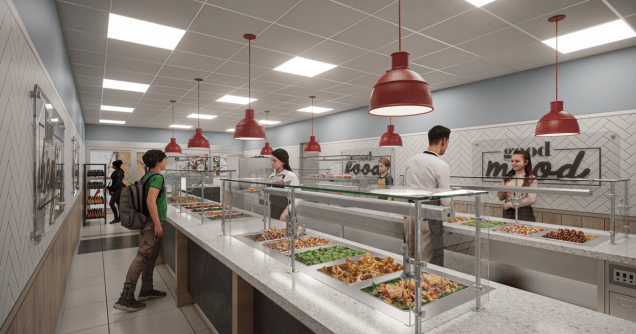
Flashback for a moment to K-12 – school lunch was the real deal (and still is). It’s that cherished time for kids to chat, chow down and recharge before heading back to class. However, in many schools nationwide, the limited duration allocated for lunch poses a challenge. On average, elementary schools provide around 25 minutes, while middle and high schools offer approximately 30 minutes. Unfortunately, valuable time is often consumed as students contend with long lines for food.
Fostering a culture of well-being and encouraging wholesome eating habits among students today (and back then, too) hinges significantly on cafeteria serving line designs. Beyond serving meals, these designs play a big role in creating an inviting and comfortable environment for students, contributing to an overall positive dining experience.
Improving serving line flow
Efficient serving line designs prioritize the flow of students through the cafeteria, aiming to reduce congestion and wait times. A popular approach is the implementation of a linear layout, strategically placing food stations in a straight line to enable swift movement from one station to the next. This design minimizes congestion during peak hours, incorporating well-defined pathways and ample space between food stations to ensure comfortable navigation for students, contributing to stress-free dining.
Encouraging healthy choices
In addition to the layout, efficient cafeteria designs emphasize the promotion of healthy food choices. Numerous studies have highlighted the positive influence of altering the layout and setting in school lunchrooms, where environmental changes shape students’ decisions on food choices.
Eye-catching presentations spotlight nutritious meal options, positioning fruits, vegetables and other wholesome foods at eye level. Take, for example, Low Temp Industries’ (LTI) TempestAir cold pans, designed for effortless self-service. Notably, these pans sit seamlessly flush with the counter, enhancing the visual appeal of the offerings.
For cafeterias short on space, LTI also offers quick-serve food carts and kiosks, perfect for grab-and-go style foods, which can also be outfitted with QuickSwitch™ serving technology or ceramic glass merchandisers. More on technology to come.
Additionally, the incorporation of vibrant signage and engaging graphics further reinforces the nutritional benefits of various food items, encouraging students to make informed dietary choices. Adjustable-height counters empower young students to access food items easily, promoting independence and confidence in selecting their meals.
Customizing serving stations for inclusivity
Recognizing the diverse dietary preferences and requirements of students, high-efficiency serving lines often incorporate customizable stations offering vegetarian, vegan, gluten-free and allergen-free options. This ensures inclusivity, allowing all students to enjoy a satisfying and nourishing meal, while fostering a sense of belonging within the school community. Dedicated allergy-friendly zones and clear ingredient labeling contribute to a safe and welcoming dining environment for students with specific dietary restrictions.
Transforming student dining through tech
The integration of technology into school cafeteria serving line designs has become increasingly prevalent in the digital age. From self-service kiosks for faster checkout to interactive menu displays providing nutritional information, technology-driven solutions enhance the efficiency and transparency of the dining experience. Digital platforms facilitate cashless payment systems, reducing transaction times and minimizing the use of physical currency. Feedback mechanisms through digital interfaces enable students to voice their preferences and concerns, allowing schools to adapt their menu offerings and dining services according to evolving student needs and preferences.
To diversify cafeteria menus and boost student engagement, integrating foodservice technology, such as LTI’s QuickSwitch, offers a high level of flexibility. QuickSwitch allows foodservice staff to transition between hot, cold and frozen settings in 60 minutes or less, incorporating a variety of fresh food options into menus and enhancing overall cafeteria efficiency.
Promoting a healthier future generation
At the end of the day, efficient cafeteria serving line designs are instrumental in creating an environment where students can make healthy choices and enjoy their lunchtimes.
By prioritizing flow, healthy options, diversity and technology these designs contribute to a positive and enriching school dining experience. Incorporating advanced technological solutions, such as LTI’s QuickSwitch, TempestAir and Mobile Food Carts ensures optimal cafeteria infrastructure for seamless operations and maximum student engagement. Educational institutions that prioritize these high-efficiency designs effectively nurture a culture of wellness and conscientious eating habits among their student body, aligning with the broader goal of promoting a healthier future generation.
For more insight on how to implement these design strategies and improve your school cafeteria’s serving line flow, contact the industry leaders at LTI
